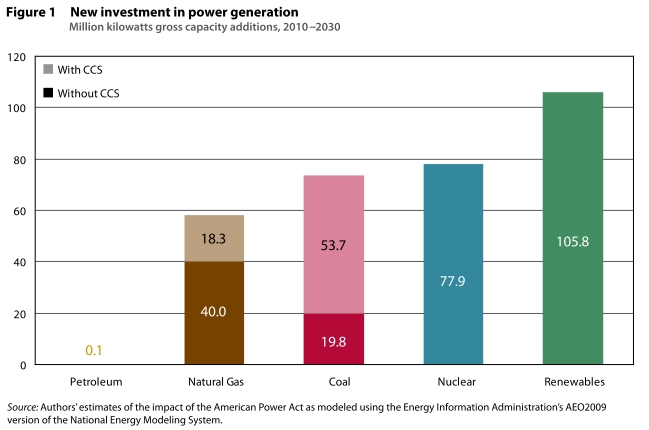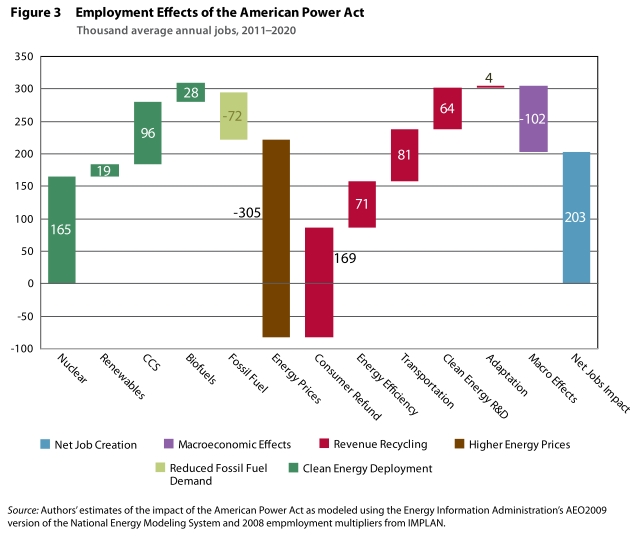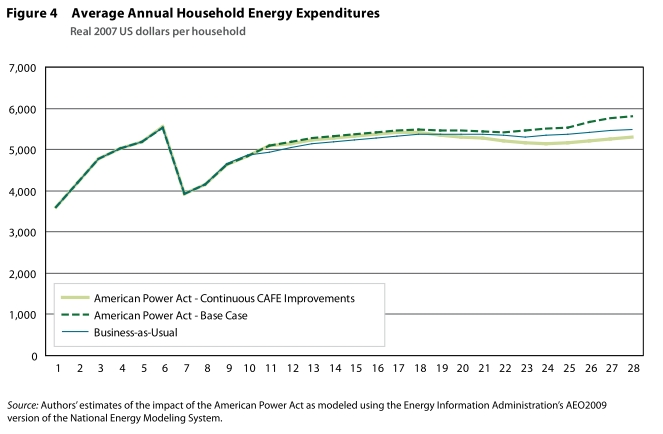The top-notch climate/energy team at the Peterson Institute for International Economics has just released a comprehensive assessment of “the economic, employment, energy security, and environmental impact of the American Power Act” (by Trevor Houser, Shashank Mohan, and Ian Hoffman). I’ll post their main conclusions below, but first a quick point.
PIIE’s analysis focuses on the tangible effects of the bill in terms of jobs, energy sources, and emissions. These are the numbers greens should be campaigning around. The left is constantly mired in technocratic debates over mechanisms — cap-and-trade or carbon tax? auction or free allocation? Clean Air Act or not? The conversation has become inward-looking and inscrutable; the public has tuned out.
It’s the goals of the legislation that normal people care about. How much carbon pollution do we want to reduce? What kind of power do we want to use, and how much? How many jobs do we want to create? These are questions with which average citizens can meaningfully engage.
There are many policy mechanisms that could move these numbers. The question is, which numbers do you focus on? For my part, I think the amount of renewable energy produced by the bill is mediocre. The amount of efficiency is pathetic. My key goals would be:
- More clean energy and less dirty energy. The best way to do that in the next 20 years is by boosting the renewable energy standard (RES) in Sen. Jeff Bingaman’s (D-N.M.) energy bill. The next best is to divert more allowance value to investment in clean energy RD&D. The third best is to strengthen the coal power plant standards and eliminate the offshore drilling incentives.
- Lower household energy expenditures. The best way to do that is by creating a strong energy efficiency resource standard (EERS), which would mandate that utilities get a certain portion of their new supply from efficiency. The next best is to mandate that local distribution companies (LDCs) use a portion of the allowance value they pass on to ratepayers for efficiency programs instead of rebates. The third best is to implement innovative financing programs like PACE on a nationwide scale. The fourth would be to strengthen the bill’s transportation section.
- More jobs. A stronger RES and EERS will both create jobs. Direct public investment will create jobs, particularly during a downturn. Any dollar of investment that is diverted from oil does more work creating jobs here than it does sitting in a Saudi Arabian bank. And jobs come from new industries and innovations — that means industrial policy.
These strike me as reasonable goals for the green movement as a whole, since the public already supports them, but sadly I’m not king. Regardless of which goals are prioritized, the debate ought to be about outcomes, not tools and widgets. If voters are to be engaged and activated, the focus must be dragged back to what they care about: clean energy, jobs, and economic competitiveness.
Now, here are the principal findings from PIIE’s analysis:
Energy Sector Changes: The American Power Act would significantly alter the way the United States produces and consumes energy. The share of total energy demand met by fossil fuels would fall from 84 percent today to 70 percent in 2030. Renewable and nuclear energy would grow from 8 percent of U.S. energy supply today to 16 and 14 percent respectively in 2030.
 Peterson Institute for International Economics
Peterson Institute for International Economics
Energy Security Implications: The Act would reduce U.S. oil imports by 33 to 40 percent below current levels and 9 to 19 percent below business-as-usual by 2030. This would cut U.S. spending on imported oil by $51 to $93 billion per year and, by lowering global oil prices, reduce oil producer revenues by $263 to $436 billion annually by 2030.
Environmental Impact: The Act would establish an economy-wide carbon price starting at $16.47 per ton in 2013 and growing to $55.44 dollars per ton in 2030, reducing greenhouse gas emissions from covered sources 22 percent below 2005 levels by 2020 and 42 percent by 2030.
Employment Effects: The Act prompts $41.1 billion in annual electricity sector investment between 2011 and 2030, $22.5 billion more than under business-as-usual. This stimulates U.S. economic growth and job creation in the first decade, increasing average annual employment by about 200,000 jobs.
 Peterson Institute for International Economics
Peterson Institute for International Economics
Impact on Consumers: By pricing carbon, the American Power Act raises the price of fossil fuels for businesses and consumers. Households see an average 3 percent increase in electricity rates and 5 percent increase in gasoline prices between 2011 and 2030. Energy efficiency improvements largely offset these energy price increases — households see somewhere between a $136 increase and a $35 decrease in average annual energy expenditures, depending on future improvements in vehicle efficiency.
 Peterson Institute for International Economics
Peterson Institute for International Economics
——
One quick additional note.
This analysis is unusually comprehensive. A lamentably large portion of climate policy modeling confines itself entirely to the cap-and-trade system, producing results that are then improperly used as proxies for the overall legislation’s effects. PIIE takes into account energy subsidies, efficiency standards, loan guarantees, consumer dividends, heavy industry protections, and vehicle incentives. It includes the Energy Committee’s ACELA bill, which is expected to be included by reference. It also, crucially, does not assume full employment — it acknowledges that federal spending during an economic downturn can have stimulative effects. (An amazing number of analyses start with the assumption of full employment.)
By necessity this kind of broader look at a suite of policies produces a wider range of predictions, which can make simplicity-seeking legislators uncomfortable, but it has the virtue of being much more realistic about what we do and don’t know.
I’m obliged to add, though, that I think the models at the core of this kind of exercise are deeply flawed in ways that overestimate costs and underestimate benefits. I hope somebody in 2020 goes back and assesses all these assessments, to try to learn something from them. I suspect what we’ll learn is that we should be more optimistic.

